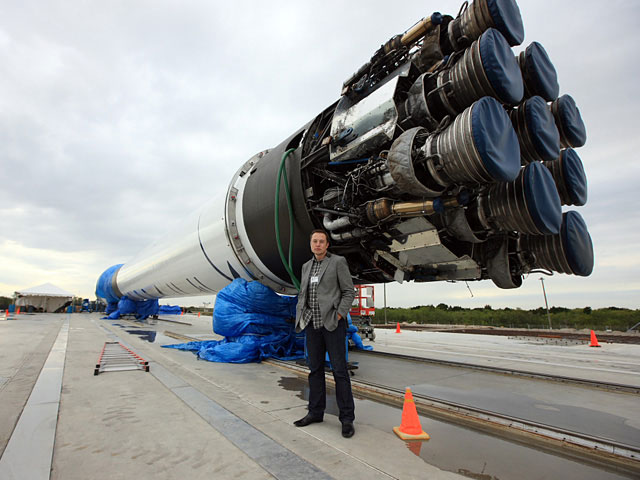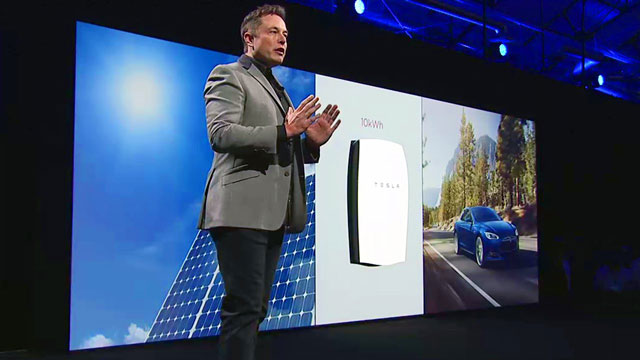
While wind and solar power have made great strides in recent years, with renewables now accounting for 22% of electric energy generated, the issue that has held them back has been their transience. The sun doesn’t shine at night and the wind doesn’t blow year-round — these are the mantras of all those opposed to the progress of renewables.
Now the renewable power billionaire Elon Musk has just blown away that final defence. Last Thursday in California, he introduced to the world his sleek new Powerwall — a wall-mounted energy storage unit that can hold 10kWh of electric energy, and deliver it at an average of 2kW, all for US$3 500.
That translates into an electricity price (taking into account installation costs and inverters) of around $500/kWh — less than half current costs, as estimated by Deutsche Bank.
That translates into delivered energy at around $0,06/kWh for the householder, meaning that a domestic system plus storage would still come out ahead of coal-fired power delivered through the conventional grid.
What’s more, Musk is going to manufacture the batteries in the US, at the “gigafactory” he is building just over the border from California in Nevada. He is not waiting for some totally new technology, but is scaling up the tried and tested lithium-ion battery that he is already using for his electric vehicles.
Now the fossil fuel companies — from fuel suppliers such as coal miners to coal-burning electric power utilities — will be on the defensive, fighting the new normal of cheaper renewable supplies and storage. Instead of asking, “Can we have our own energy system?”, communities will be asking, “Why can’t we have it?”
The Tesla Energy system launched last week is comprehensive, with global ramifications. The Powerwall system offering 10kWh is targeted at domestic users. It is complemented by a commercial system termed the Powerpack offering 100kWh storage, and a stack of 100 such units to form a 10MWh storage unit that can be used at the scale of small electricity grids.
Whole communities could build micro-grid power supply systems around such a 10MWh energy storage system, fed by renewable energy generation (wind power or rooftop solar power), at costs that just became super-competitive.
At his launch last week, Musk maintained that the entire electric power grid of the US could be replicated with just 160m of these utility-scale energy storage units. And 2bn of the utility-scale units could provide storage of 20 trillion kilowatt-hours — electric power for the world.
It is instructive to put these numbers in context. There are already around 2bn cars and commercial vehicles on the world’s roads, and nearly 100m new vehicles are being added every year.

If it’s feasible to build these exhaust-pumping complex machines, it’s certainly feasible to build the storage units that will help to make them unnecessary. What’s more, Musk has just announced that he intends to do so.
Musk is a Henry Ford-style figure who takes others’ innovations and scales them up, taking the breathtaking entrepreneurial leaps that others can only dream about. Suddenly, the world of renewable energy just moved to become the new normal — because when combined with cost-effective storage, it becomes unbeatable.
Musk will not be alone. Already China is gearing up to be the world’s renewable energy superpower, with the largest installed base of wind power and probably by this year the world’s largest installed base of solar photovoltaic (PV) power, as well as by far the world’s largest manufacturing system for wind turbines and solar photovoltaic cells.
There are already Chinese companies such as BYD producing their own energy storage units based on lithium ion technology for both domestic and commercial usage — although not as sleek nor as cheap as the new Tesla offering.
But give them time and they will be producing at comparable scale and cost, or bettering it. This is capitalist competition — and its propagation is what makes Tesla’s announcement the start of the real renewables revolution.
China has given the world a huge lesson in the business-like way it has gone about building and promoting its renewable energy industries, importing technology from around the world and now improving on it as well, and scaling up production so as to drive down costs.
Now Musk and his Tesla Energy have just taken that process one decisive further step, to encompass storage as well as renewable power generation. From here, there is no going back.![]()
- John Mathews is professor of strategic management at the Macquarie Graduate School of Management at Macquarie University
- This article was originally published on The Conversation




